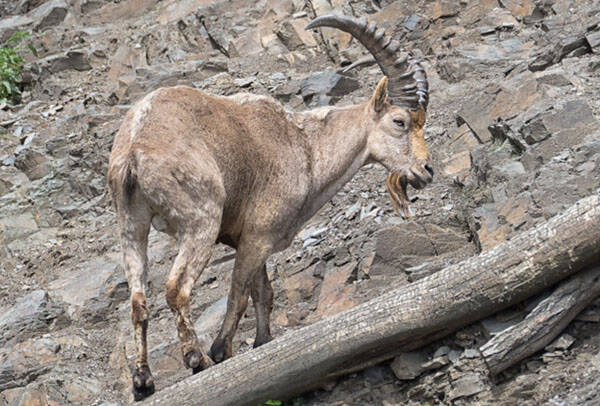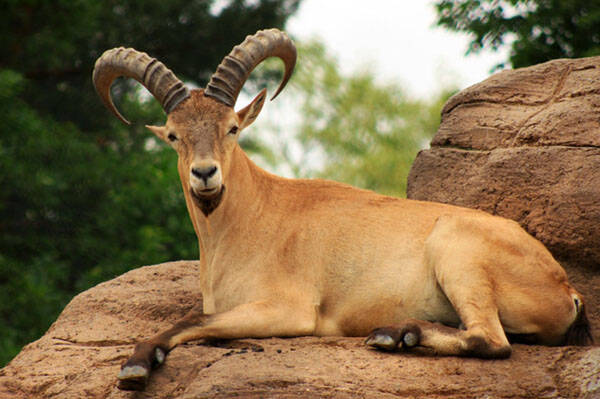Capra caucasica
IUCN
LCBasic Information
Scientific classification
- name:Capra caucasica
- Scientific Name:Capra caucasica
- Outline:Ungulata
- Family:Artiodactyla Bovidae Capra
Vital signs
- length:120-165cm
- Weight:50-100kg
- lifetime:12-13years
Feature
The fur is chestnut, the lower abdomen is yellow, the legs are darker, and the horns are scimitar-shaped.
Distribution and Habitat
The West Caucasian ibex is an endemic species found in the western Caucasus Mountains in Georgia and Russia. Their distribution range extends from the Abago Mountain area (43º53'N, 40º08'E) to the source of the Large Zelenchuk River (approximately 43º21'N, 41º17'E) and the source of the Bzyb River on the northern slopes in a narrow strip to the southern slopes.
The habitat and ecology of the West Caucasian ibex do not differ significantly from those of the East Caucasian ibex. The western region is more affected by heavy precipitation and snow. The West Caucasian ibex mostly inhabits subalpine and alpine zones between 800-4000 meters above sea level. They rarely live in forests outside the snow season, probably because the forests of the West Caucasus are mainly composed of fir and spruce, forming closed forest belts. Where pine trees are more abundant, the ibex is more likely to remain in the forest. During the severe winters in the region, the ibex concentrate
Appearance
Adults weigh 65-80 kg, up to 100 kg, females 50-60 kg; head-body length males 150-165 cm, females 120-140 cm; shoulder height males 95-109 cm, females 78-90 cm; tail length 10-14 cm. The summer coat of the West Caucasian ibex varies from rusty gray to tan, while in winter the coat darkens to gray-brown. In older animals this may be much lighter. The underparts are usually the same color as the rest of the body in the summer coat, lightening to yellow-gray or dirty white in winter, especially in females. There is no obvious dark dorsal stripe like in some other wild goat species. The chest is dark reddish brown. The moulting of the winter coat begins in March and lasts until mid-June. The guard hairs and undercoat of the coat begin to grow longer in September, and by the end of October, the full winter fur is fully grown.
The body is large, with a relatively long torso; the legs are short and sturdy. The front surface of the legs is dark brown, becoming darker and more intense toward
Details
West Caucasian ibex (scientific name: Capra caucasica) English Western Tur, Tur, West Caucasian Tur, Spanish Tur occidental, German Westkaukasischer Steinbock, Russian Западнокавказский тур, Кубанский тур, no subspecies.

The herd composition of the West Caucasian ibex varies greatly during the year. From May to November, males live at higher altitudes, thereby distinguishing themselves from females and young ibex. In summer, females form groups of about 12. In November, West Caucasian ibex migrate 1500-2000 meters downward for the mating season. During this period, the herds are mixed and can number more than 500 individuals. Then in May they rise to higher altitudes and break up into smaller groups. In the summer, the species takes shelter and rests during the hottest hours of the day. Females provide all the care for their young.
The West Caucasian ibex is a herbivore. The diet in the summer consists of a wide variety of plants and grasses. They tend to feed in the morning, rest in the afternoon heat, and then feed again in the evening and evening. In the winter, their diet consists of leaves from trees and shrubs, grazing in open pastures throughout the day. If the West Caucasian ibex's resting and feeding sites are separated, they can walk up to 20 kilometers a day.

The mating season for the West Caucasian ibex lasts from late November to early January of the following year. During this season, males fight fiercely for females. Gestation lasts 150-160 days. Usually only one calf is born per litter, rarely two, and the average birth weight is 3.5-4.2 kg. Although the calves start to eat grass at about 1 month old, they are not weaned until they are 3 months old. Females reach sexual maturity around 2 years of age, males around 5 years of age. Life expectancy is 12-13 years.
The total population of the West Caucasian ibex in the late 1980s was estimated at about 12,000 animals (1997), and in 2001, the number was estimated at 6,000-10,000. Until 2015, there were about 2,000-2,500 West Caucasian ibex in the Caucasus Biosphere Reserve, but data from 2016-2017 indicate an increase to more than 3,000 (Trepet 2018). In Georgia, in the 1990s, 2,500 animals were estimated (NACRES 1996), and in the 2000s, 1,000 animals were estimated (Kopaliani and Gurielidze 2009). However, data from 2018 prove that there are only about 100 West Caucasian ibex in Georgia. Such absolutely different numbers may be caused by different methods of taxonomy of West Caucasian ibex. Weinberg (2004) gave a total population of 5,000-6,000 animals, but the actual estimate may be closer to 4,000-5,000, not only because of the decline, but also because of different classification methods. Therefore, the apparent decline from 6,000-10,000 animals in 2001 to 4,000-5,000 animals in 2019 would be unrealistic.
Listed in the IUCN Red List of Threatened Species in 2019 ver3.1 - Endangered (EN).
Protect wild animals and eliminate game.
Maintaining ecological balance is everyone's responsibility!








